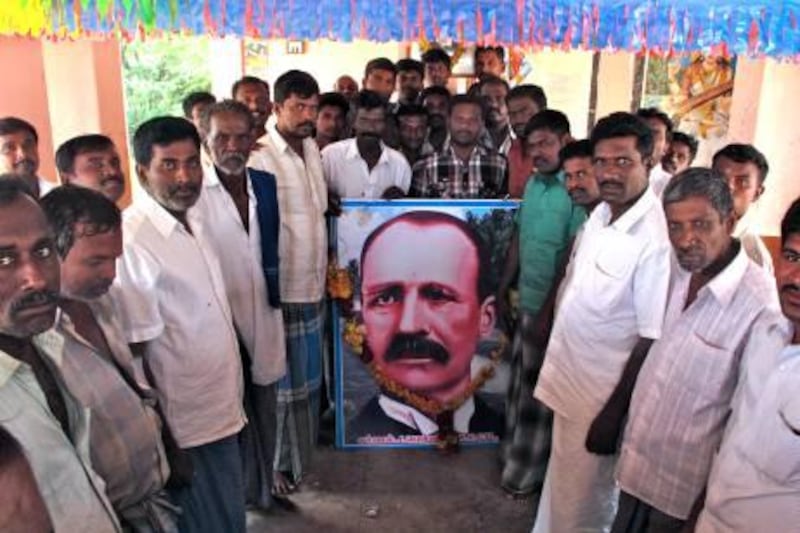PALLAR PATTI, INDIA // Claims that a century-old dam could collapse and kill up to three million people in southern India are considered blasphemy in one remote village, where its British colonial designer is regarded as a god.
The dispute over the Mullaperiyar Dam, in the border region between the states of Kerala and Tamil Nadu, has grown increasingly bitter. In recent months, violent attacks and even rape have been reported by workers crossing the border.
Kerala claims the dam, which was completed in 1895, could collapse at any moment, submerging three million people who live downstream on its side of the border.
For many on the Tamil Nadu side, which receives most of the benefits from the rivers created by the dam, such claims are sacrilege.
In the tiny hamlet of Pallar Patti, the man who built the dam, a British engineer called John Pennycuick, has achieved divine status.
His portrait hangs alongside that of Lord Krishna in the small temple in the centre of town.
Posters featuring his face adorn the walls of many homes and businesses, and a large billboard at the entrance to the village portrays him riding a chariot, with the faces of the current and former Kerala chief ministers superimposed on his horses.
"He has been elevated to the level of god here," said P Andi, a resident. "On his birthday, we pour milk over his portrait - which we only do for the most sacred gods."
The reverence is not hard to understand. Once an arid, dusty plain in which few crops could grow, this part of Tamil Nadu was one of the worst-hit regions during the famines that swept India in the latter half of the 19th century, taking millions of lives.
Today, Pallar Patti is rich and fertile - multiple crops of rice are grown each year, large banana and sugar plantations line the picturesque riverbanks and almost every villager rides a new motorcycle.
"If Pennycuick had not constructed this dam, these people would not have life," said S Dorai Samy, a retired history professor who lives in Pallar Patti. "It is natural that he should become a god."
From the crowd that has gathered around us, he points out three children called John.
Pennycuick's story has the perfect ingredients for myth-making. According to the legend, he single-handedly spearheaded the creation of the dam against great odds.
When a monsoon storm destroyed two years of work and the British government backed out of the project, Pennycuick is believed to have sold his property and emptied his life-savings to see it through.
"Although the British were of course only interested in maximising their revenue, this was still an area of disease and wild animals, with no roads or communications. He gave nine years of his life. It was a great sacrifice," said Mr Samy.
The dam primarily serves the plains of Tamil Nadu, but the construction itself lies in Kerala, in what was then the kingdom of Travancore. To secure land rights, the British signed a lease agreement with the maharaja for 999 years. That lease is now at the heart of the dispute between the two states.
Tamil Nadu has been pushing for an increase in the dam's water level, but it has been blocked by Kerala, which wants the dam replaced by a newer, safer model.
Engineers have tended to agree with Tamil Nadu that the dam is safe, but the issue is clouded by politics, especially in Kerala, where the Congress government rules with a razor-thin, single-seat majority and faces a by-election in April.
There are even unconfirmed reports that the Kerala government quietly funded a disaster movie, Dam 999, in which a fictitious dam bursts its banks and kills thousands of people. The film was banned by the Tamil Nadu government after its release last year.
But TP Sreenivasan, a member of the Kerala education board who has written extensively on the issue, says that public concerns are real.
"A number of experts have taken the view that the dam is safe," he said. "But there are also reports that it cannot withstand an earthquake of more than 7 on the Richter scale, and we have had several tremors in this region recently.
"The concern is genuine among the people. The politicians have no choice but to follow them."
A committee appointed by the Supreme Court will submit its report next month, and is expected to suggest the construction of a new dam. That will likely involve a renegotiation of the water-sharing treaty, which many believe is the real motivation behind the dispute.
"Under the 999-year lease, Kerala gets a million rupees a year, which is minuscule," said Mr Sreenivasan. "Tamil Nadu knows there will be a revision of the money if a new dam is built."
Tamil Nadu has been burned before and fears any loss of control over the dam. A disagreement with state of Karnataka over sharing the Kaveri River led to angry demonstrations in 2002 after the Karnataka government refused to release promised water volumes despite an order from the Supreme Court.
In Pallar Patti, the villagers are ready for a fight.
"We haven't had a people's movement like this since independence," said Prof Samy. "We will not allow the name of Pennycuick to be ruined by this propaganda from Kerala."





